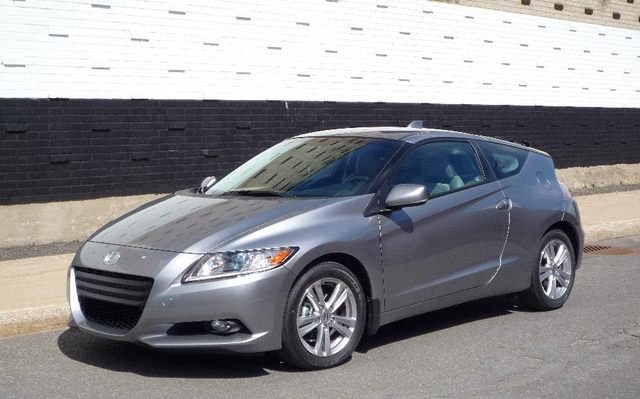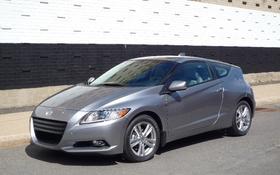2012 Honda CR-Z: Half green, half sport?

| Strong points |
|
|---|---|
| Weak points |
|
Honda never ceases to amaze us. Their technical and aesthetic choices are never influenced by other models on the market. The Japanese manufacturer does, however, sometimes find inspiration in the past to come up with vehicles adapted to today’s needs. And the CR-Z proves it. This two-door hybrid should logically be the follow-up to Honda’s first hybrid offered in the Americas, the Insight. It debuted in 1999 and stopped being produced in 2006. Not only did this car consume less fuel than any other vehicle offered at the time, it still holds the record for greatest fuel economy for a tourer.
But the Insight was practically a lab on wheels, and its production costs were colossal. Honda decided to halt production and replace it with another model by the same name (it came out last year). This more recent Insight lacked the eccentric silhouette of its namesake. In fact, it was a Fit with a hybrid engine and a somewhat modified physique to look a little more like other hybrids. And now, this year, Honda is presenting us with the CR-Z, whose shape is inspired by the legendary CRX coupe of the 80s. While this car wasn’t the most powerful on the road with its 91 hp engine (108 hp by the end of its career), but it sure was fun to drive. Honda’s mission is to offer a hybrid coupe inspired by a legend of the past. And according to the manufacturer’s press releases, this newcomer intends to add a splash of sport to the world of hybrid cars.
Daring style
You don’t need to be a design specialist to realize that this car looks like nothing else on the market these days. In fact, it bears very little resemblance to the first Insight. But you just can’t help but draw some parallels to the 1995 CRX. And, curiously, the CRX’s silhouette enjoyed its share of controversy. When it first appeared on our market, dealers didn’t want to carry it because they thought it was ugly. Within a few months, it was the market favourite, and people were clamouring to get one. The 2012 CR-Z has adopted the same lines of this predecessor, with a very long hood and a stout and raised rear. In both cases it’s a two-seater. Like the current Insight, the hatch is a vertical window. We should also mention that the rear section is slightly raised, but its rear window is nearly horizontal. This improves the car’s aerodynamics as well as trunk space. In fact, once the false rear seat back is folded down, cargo space is 711 litres, which is pretty impressive for a car of this size.
Since this is a two-seater car, front passengers get all the space they need. The seats are comfortable and offer great lateral support. Honda got it right by not offering teeny-tiny seats in the back, as is the case in other markets. That would have been a total waste. Instead, they’ve added small storage compartments that are actually quite practical. You can tuck your valuables out of sight by folding down the false seat back. The baggage cover can be removed and put back into place easily.
A little 3-D
3-D movies are all the rage these days, and it seems to have influenced dashboard design – at least the speedometer and tachometer. A digital display indicates your speed in the centre of the round dial. You can set it to kilometres or miles with the touch of a button on the left side of the dash. This dial is raised higher than the tach – a 3-D effect that allows both elements to fit into one round ring, which, incidentally, changes colour depending on your speed. Green means that your fuel consumption is low. Blue means you’re in the normal range. And boo to all drivers in the red zone; they clearly aren’t thinking about their fuel economy! With this kind of simple, easy-to-read gauge, you feel motivated to keep your fuel consumption in the more environmentally friendly range. The rest of the dashboard is very simple. To the driver’s right is a section for climate control and some very easy-to-use radio controls. Also worth noting is that the driving position is excellent.
Like any self-respecting hybrid, this car offers drivers three driving modes: Econo, Normal and Sport. Three buttons on the lower left-hand side of the dash control the settings. A little higher up on the left is a screen that tells you when to change gears and which driving mode you’re in. Finally, on the lower right-hand side of the dash you find screens indicating your current fuel consumption rate, your average fuel consumption rate, the number of kilometres before you run out of gas and a plethora of other information. There’s even a small table measuring how efficient your driving is (with regard to fuel consumption). All these are simple and easy-to-read. However, you have to make sure that all this information doesn’t distract you. Green driving is good, but safe driving is even better.
Sporty, green or retro
Honda’s press releases mention a hybrid car with sport ambitions. Maybe that’s because of the CR-Z’s Sport mode, which delivers a more nervous punch from the electric engine assistance. Indeed, Honda has stayed true to its Integrated Motor Assist technology, which consists of a small electric engine placed between the internal combustion engine and the transmission. When the engine is running, the electric engine provides a surplus of power, which results in more nervous accelerations and pick-up compared to a 1.5-L combustion engine alone. Paired with the electric engine, the 1.5-L engine can produce 122 hp. Two transmissions are offered with this. A manual six-speed comes factory-standard, and a continuously variable automatic transmission is available as an option. Our test vehicle was equipped with the manual gearbox, and we really liked it. The throw between gears is short, the stick shift is precise and the clutch is a real charm. The pedal support is well-positioned and the aluminum pedals add a sporty touch to the vehicle.
But is this hybrid really sporty? Before answering this question, we should mention that Honda engineers put a lot of work into developing a very rigid body out of extra-rigid and extra-light steel. The components of the front suspension are aluminum, while the rear suspension features an H-shaped torsion beam. This rear portion takes up less space, which makes way for the batteries in the rear of the vehicle.
But let’s get back to our topic: vehicle handling. Those who remember the CRX and its kart-like handling will be disappointed. The CR-Z is bigger, heavier by about 200 kg, longer and wider. And its power steering is certainly not as direct as the non-assisted steering of the old CRX. But if you look at the car from a more modern perspective, you’ll discover that it’s pleasant to drive and offers decent (if not astounding) performances. It took us 8.9 seconds to go from 0-100 km/hr in Sport mode.
As for the CR-Z’s road handling, it’s relatively good. On long turns, this car hangs on. That said, it’s not the best car for gymkhanas. If you push it too hard, its tail is definitely going to let go. In fact, you could go as far as to call this a suburban vehicle with sporty tendencies and a hybrid calling. The driving pleasure and performances it affords are certainly not up to sports car standards, but they are definitely a cut above several of the anaemic and boring sub-compacts you find out there.
Transporting you from home to work in the morning, this vehicle navigates traffic with ease, and its fuel consumption, though a little disappointing, is nonetheless reassuring. And the ample cargo space means you can get all your errands done on the way home.
If this vehicle has a shortcoming, it’s the fact that its fuel consumption is not as low as we might have hoped. According to Honda, its average should be 6.5 L/100 km (city driving) and 5.3 L/100 km (highway driving). And yet, despite our best efforts, we never used less than 7 L/100 km, which is about what you’d get in a conventional Honda Fit.
But aside from that, it’s a green vehicle that’s well worth considering.











